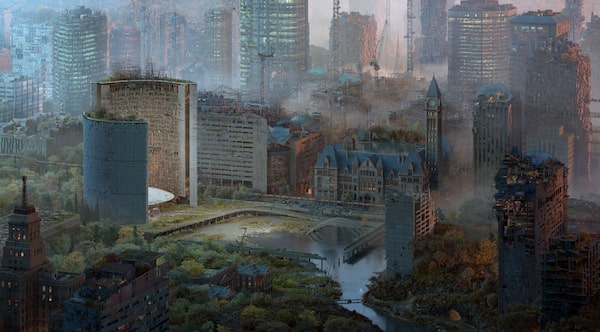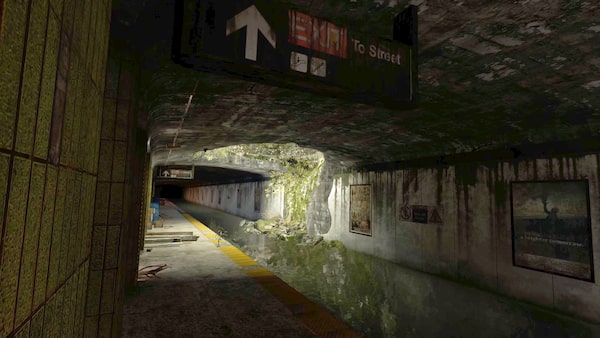
Lisa Jackson's virtual reality film, Biidaaban: First Light imagines a future Toronto, one in which nature has reclaimed the city – and imperilled languages have been reborn.
The other morning, I was standing on top of a tall building on Bay Street, across from Toronto’s Old City Hall, but everything looked much different than usual.
There were no electric lights, just the blue-grey dawn. The buildings were crumbling, taken over by trees and moss. The pond in front of City Hall was a big puddle, and once-busy streets had become waterways. I stepped toward the roof’s edge to get a better look, but cautiously, in case I fell.
The experience felt almost real, but it was virtual, part of Lisa Jackson’s Biidaaban: First Light, which is having its Canadian premiere after being recognized at the Tribeca, Los Angeles and Melbourne film festivals.
On this week in Nathan Phillips Square and then at the ImagineNATIVE festival in October, the film imagines a future Toronto, one in which nature has reclaimed the city – and imperilled languages have been reborn.
Is virtual reality about to break through as an artists’ medium?
Biidaaban achieves what virtual reality often fails to do: creating a genuine 3-D immersion. “I’m not a technology fangirl,” Ms. Jackson said. “I like making projects that make sense, and I think in this case, VR has really offered something.”
That something is a chance for viewers to “escape the hyper-rational kind of Western way of looking at the world," she said – in other words, to get out of their heads. "VR in this case is really able to put people into that place. They have a deeper, less intellectually oriented experience.”
Also integral to the film is the use of languages once spoken widely here, before they were purposefully suppressed. Ms. Jackson doesn’t speak her ancestral language of Anishinaabemowin, but linguistics research has taught her that scholars consider Indigenous languages “radically, radically different than European languages.”

A Toronto subway station as seen in Lisa Jackson’s Biidaaban: First Light.
Most Indigenous North American languages are centred on verbs, for example, while English is built around nouns.
“Indigenous languages have a philosophy embedded within them that puts us in a different relation to the world around us and even offers different concepts of time, place and truth – very fundamental notions that we take for granted," Ms. Jackson said.
The written text of the Wendat and Anishinaabe as well as written and spoken Kanien’kehá:ka (or Mohawk) are all incorporated into the film, accenting its otherwordly futurism.
The film’s debut coincides with another moment in Indigenous language: On Monday, musician Jeremy Dutcher won the Polaris Prize for his album Wolastoqiyik Lintuwakonawa.
It’s sung in Wolastoq, the language of the Maliseet people, whose traditional territory covers parts of Eastern Canada and the United States. To compose it, Mr. Dutcher dug up century-old wax-cylinder recordings at the Canadian Museum of History.
Indigenous communities have long protected and maintained their languages, even before the Truth and Reconciliation Commission promised to revitalize them. But despite these recent artistic triumphs, all 60 Indigenous languages in Canada are still very fragile.
Only about 100 Wolastoq speakers remain. Cree is often touted as relatively strong, with many speakers, but researchers say its vocabulary has plummeted from about 600,000 words to 15,000.
And only 3,500 or so people still know Kanien’kehá:ka, some of whom recite a traditional Thanksgiving address in Biidaaban. Ms. Jackson said she won’t put that part on the internet because "certain things are sacred and they must be experienced.”
I’d say that’s true of Mr. Dutcher’s music. It will be hard to get tickets to see him now, but you should try. Like the film, his longing, resonant tenor conveys both fragility and resilience, grief and hope, loss and possibility.
Which is the bundle of emotions I took away from Ms. Jackson’s vision of a radically changed Toronto. Of course it’s strange to think of it as a place with abandoned subways, no noodle shops, no e-mail. Imagine, though, looking up at a sky devoid of artificial light to see millions, billions, zillions of stars.